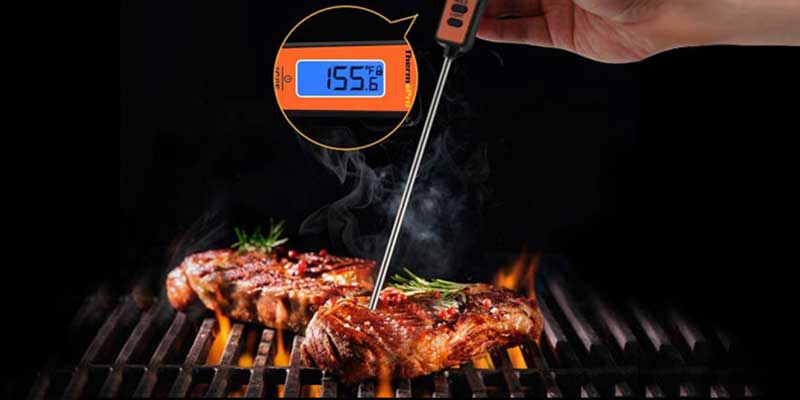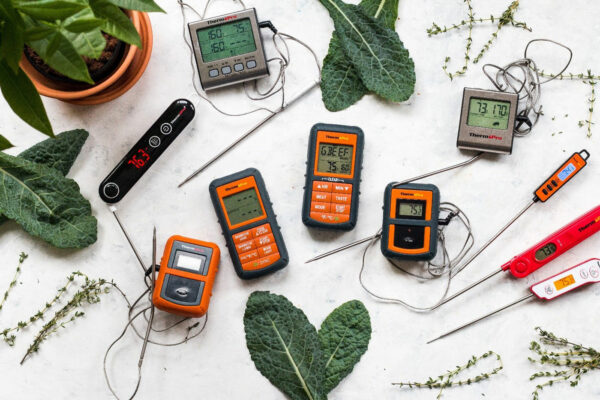The customer service team is always listening, taking notes, and quantifying complaints to ensure our products are continually improved. Due to selling directly to you, the customer, via Amazon, we can use product reviews to help us improve our existing products or help further development of new products.
Table of Contents
Improperly inserting your meat thermometer probe can result in inaccurate readings, and that can lead to you eating unsafe meats. To keep that from happening to you, we’re going to teach you all about the correct placements for most meat thermometers, and we’ll give you a few tips to help you out, too.
What Is A Digital Meat Probe Thermometer?
A probe thermometer is a thermometer that is inserted into food to record the internal temperature of the food. You should definitely have a probe thermometer in your kitchen at all times to prevent yourself from eating or serving undercooked meat products.
There are several types of probe thermometers, and we’ll list them all here.
- Dial thermometers come in instant-read and oven-safe variants. They have a long probe, and they function similarly to a watch. A pin spins around as the probe gets hotter, and you have to manually read what the temperature is when it stops. They’re more difficult to read than digital thermometers, and most of them aren’t as accurate.
- Digital thermometers also come in instant-read and oven-safe variants. They’re usually more accurate than dial thermometers, and they’re a lot easier to read.
- Pop-up thermometers are the little pins that you might see in store-bought turkeys. They’re only designed to be used once, and they stay in the meat until the meat reaches a safe temperature. You usually won’t buy these unless you’re preparing a turkey for Thanksgiving, and most store-bought turkeys come with them pre-inserted.
- Thermometer forks are often used for grilling or roasting large meats. They’re carving forks that also read the temperature of whatever foods you stick them in.
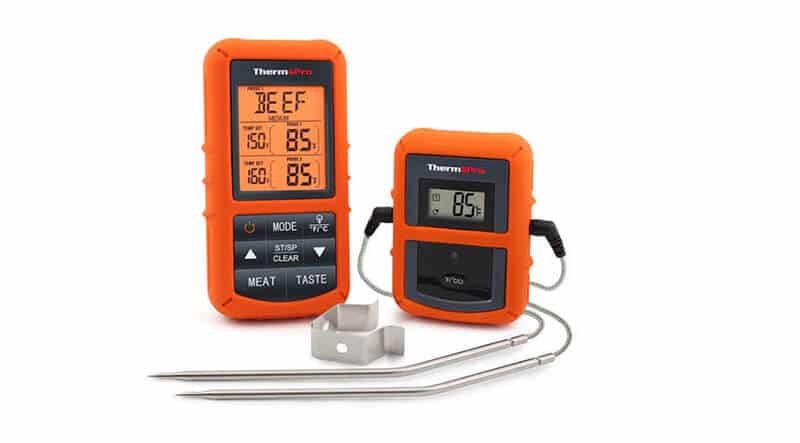
3 Things To Consider For Placing Probe Correctly
There are three things that you should take into consideration before you read your meat thermometer.
Understand Temperature Gradients
Even if you use an air fryer or an oven to cook your meat, the meat will be different temperatures in different areas. That’s called a temperature gradient.
When you insert your meat thermometer probe, different parts of the probe will read different temperatures, and those temperatures will be averaged on your thermometer’s display.
Understand The Thermal Center
The thermal center is the center of the temperature gradient, and it is typically the coldest part of your food. You want to reach the thermal center of your meat when you test its temperature. With meats such as poultry, the thermal center can be a haven for bacteria and pathogens.
Understand Your Thermometer’s Probe
Your thermometer’s probe has a sensor and a minimum insertion depth that you need to take into consideration. The sensor needs to reach the thermal center, and if you don’t insert it far enough, you’ll get very inaccurate readings.
Check your thermometer’s guide to see where your probe’s sensor is, and the guide should tell you the minimum insertion depth of your probe.
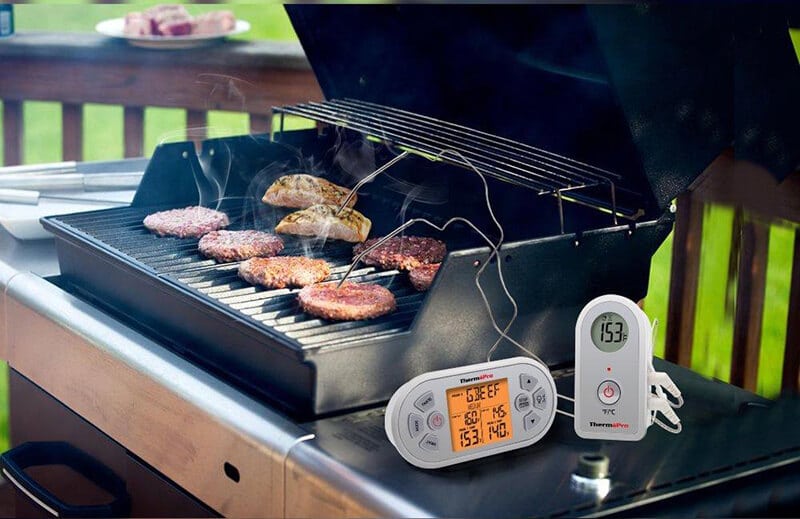
Correct Food Thermometer Probe Placement
Placing your digital thermometer probe properly will keep you from eating unsafe food, and it’ll ensure that your food is the highest quality possible. Here’s a list detailing how you should insert your thermometer into different types of meat.
Meats
In this section, we’re talking about red meats. Red meats include beef, pork, lamb, rabbit, and other mammals. To test the temperature of meat properly, you want to insert your thermometer into the thickest section possible, and you want to avoid letting the probe touch bone, fat, or gristle.
Those parts of the meat will affect the accuracy of your reading dramatically.
Poultry
The word poultry typically refers to bird meat such as chicken, turkey, pheasant, and any other type of feathered animal. Poultry often contains salmonella, and that can be deadly. So, all poultry must be cooked properly.
To test the internal temperature of your poultry, you’ll want to take multiple readings. First, insert your probe into the thickest part of the bird while avoiding bones and fat pockets. Then, insert the probe near the thigh. Both readings should be at least 165-degrees Fahrenheit.
Thin Meats
If you’re cooking thin steaks, burger patties, or thin pieces of poultry, you’ll have to test their temperatures differently than you would with larger meat products.
Instead of sticking the thermometer into a section of the meat, you’ll want to insert it into the side of the meat, and you’ll want to push the probe in relatively far to get an accurate reading of the entire piece of meat.
Combination Dishes
If you’re checking the temperature of a casserole, baked pasta dish, or another dish that uses meat and multiple other ingredients, you want to insert your probe into the thickest part of the dish. If the dish is the same thickness in every spot, you should insert your probe into the center of the dish.
If your combination dish uses eggs or poultry, you’ll need to check multiple spots to ensure that the entire dish is cooked evenly.
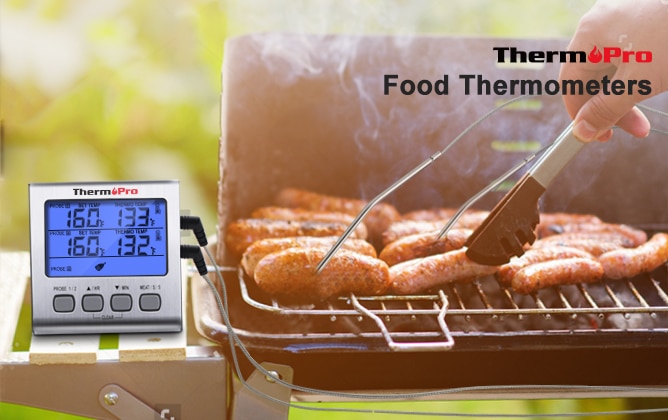
Right Probe Placement For Different Probe Thermometers
Different probe thermometers need to be inserted differently and at different times throughout the cooking process.
The following sections will cover information that will apply to most cooking processes, but you’ll have to do something a little different if you cook turkey. So, we’ll include a short guide here.
Turkey can’t be cooked properly with a single thermometer. You can safely cook a turkey with one thermometer, but it’ll probably dry out. To prevent that, insert an oven-safe thermometer near the shoulder of the bird, and push the probe into the breast.
The probe should be surrounded by meat of the same thickness on all sides.
Keep the oven-safe thermometer in that position throughout the cooking process, and then use a digital instant-read thermometer to check the thighs and breasts at the end of the cooking process.
How To Place An Oven-Safe Thermometer
Oven-safe thermometers can remain in your food throughout the cooking process. They should be placed in the thickest part of the meat, and their sensors should reach the thermal center of the food you’re cooking.
How To Place The Probe Of A Dial Instant-Read Thermometer
Dial thermometers are typically harder to get into position because of their dials, but they’re inserted the same way as most other thermometers. You insert the probe into the thermal center of the meat, wait for reading, and then remove the thermometer.
How To Place Digital Instant-Read Thermometers
You place these exactly like you do dial thermometers, but they usually read the temperature of your food a lot faster, and they’re more accurate. Just look for the thickest part of the meat, insert the thermometer, and then remove the thermometer when you get a reading.
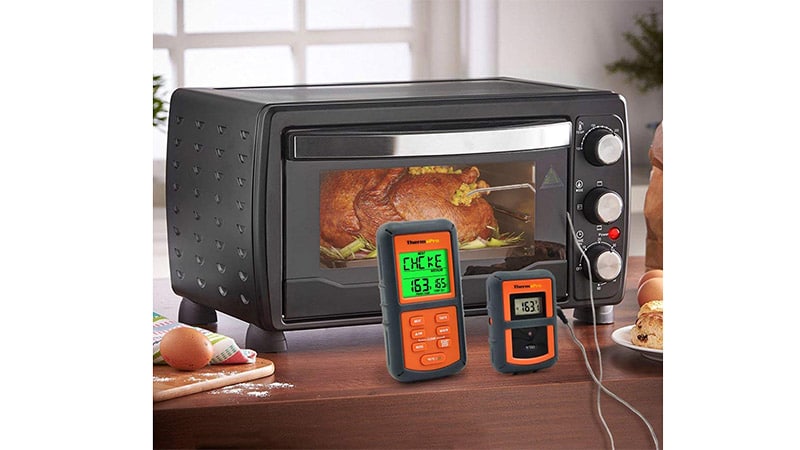
Additional Tips For Placing A Probe Thermometer
Here are a few tips to help you insert your thermometer’s probe properly.
Stay Time
Depending on the type of thermometer you use, you’ll want to remove your thermometer at a certain time. Leaving the thermometer in the meat can result in inaccurate readings.
Instant-read thermometers usually provide you with accurate readings within a few seconds, and oven-safe thermometers won’t provide an accurate reading temperature unless you leave it in the meat for most of the cooking process.
Don’t try to use an oven-safe thermometer to quickly check your food’s temperature, and don’t use instant thermometers to read your meat’s temperature of a long period of time.
Don’t Let The Probe Touch Cooking Containers
Your metal cooking pans will heat up much more than the meat you’re cooking. Do not let your probe touch the bottom or sides of your cooking vessel.
That will cause the thermometer to pick up extremely hot temperatures, and that can lead to you pulling your meat from the oven faster than you should. It can also ruin your thermometer’s sensor if you allow it to touch the metal for too long.
Take Multiple Readings
If you’re new to using a digital thermometer, you might want to take multiple readings to ensure that you’re using it properly. As you grow more comfortable with your thermometer, you’ll probably start trusting it a little more.
ThermoPro Thermometer Probe Replacement
If you’re using a ThermoPro food thermometer, you’ll want to purchase a replacement probe every once in a while. They’re easy to install, and they’re fairly inexpensive. You can find them on ThermoPro’s official website, and you can also buy them from ThermoPro’s official Amazon store.
Final Thoughts
After reading this guide, you should know exactly where and how to insert your meat thermometer. However, knowing that won’t help much if you don’t purchase a proper thermometer in the first place. We recommend purchasing all of your meat thermometers from ThermoPro.
ThermoPro thermometers are faster, more accurate, and easier to use than other meat thermometers on the market, and they’re sold a fair price.

